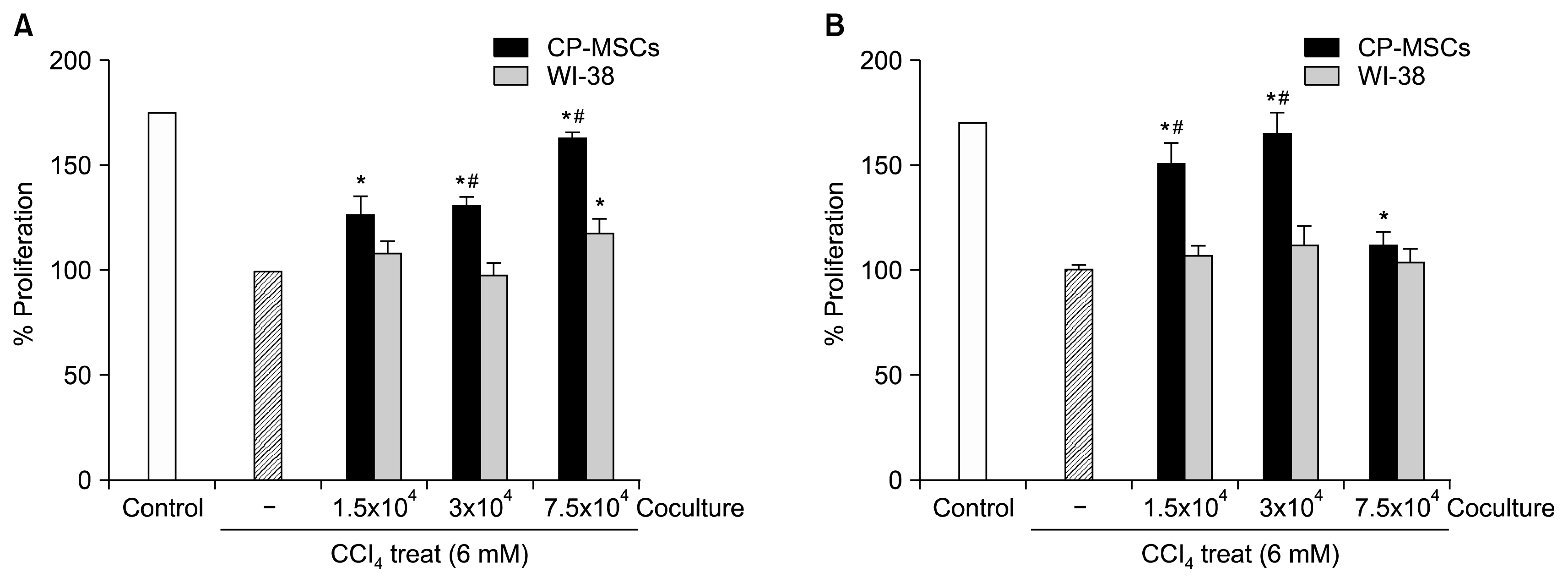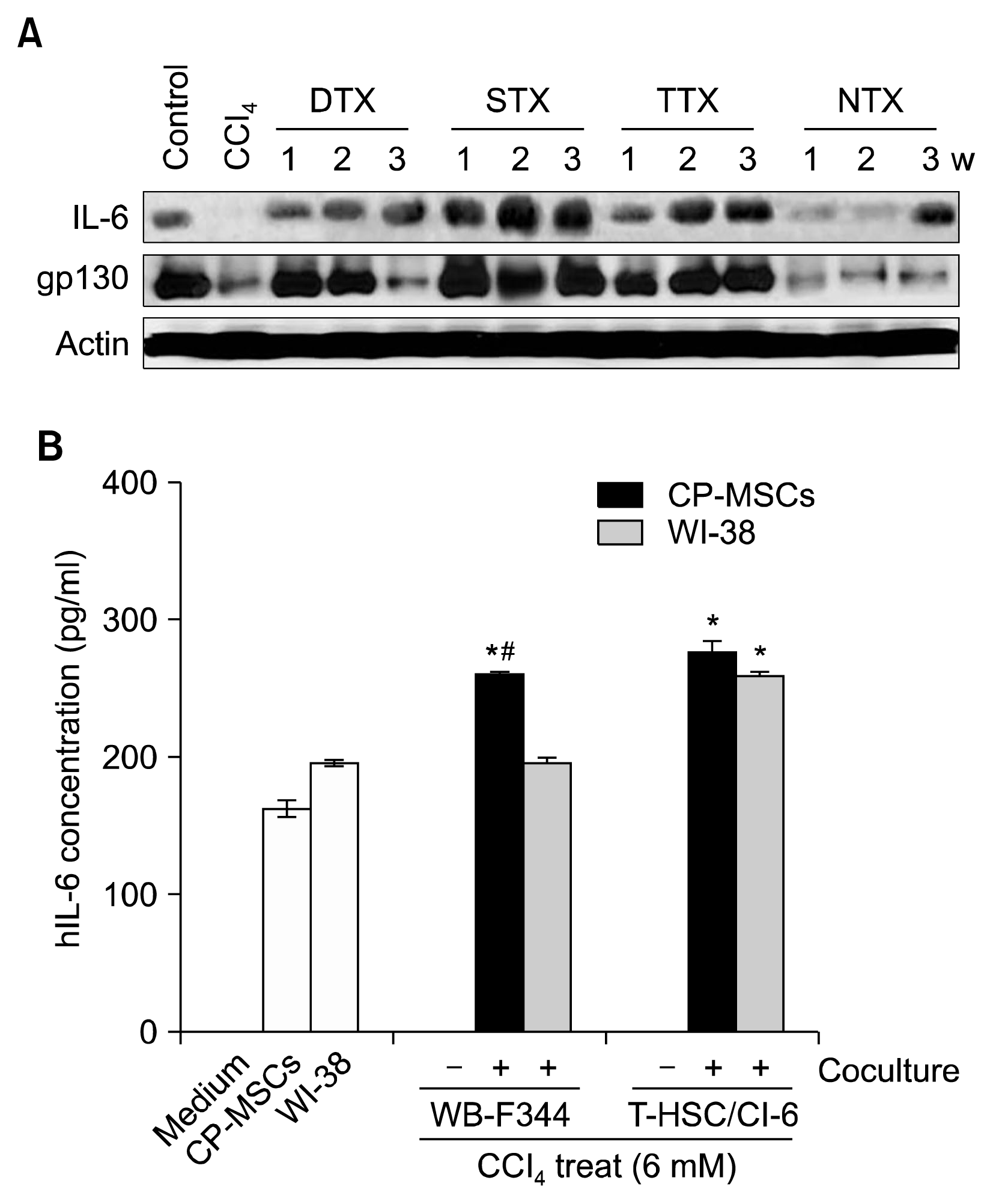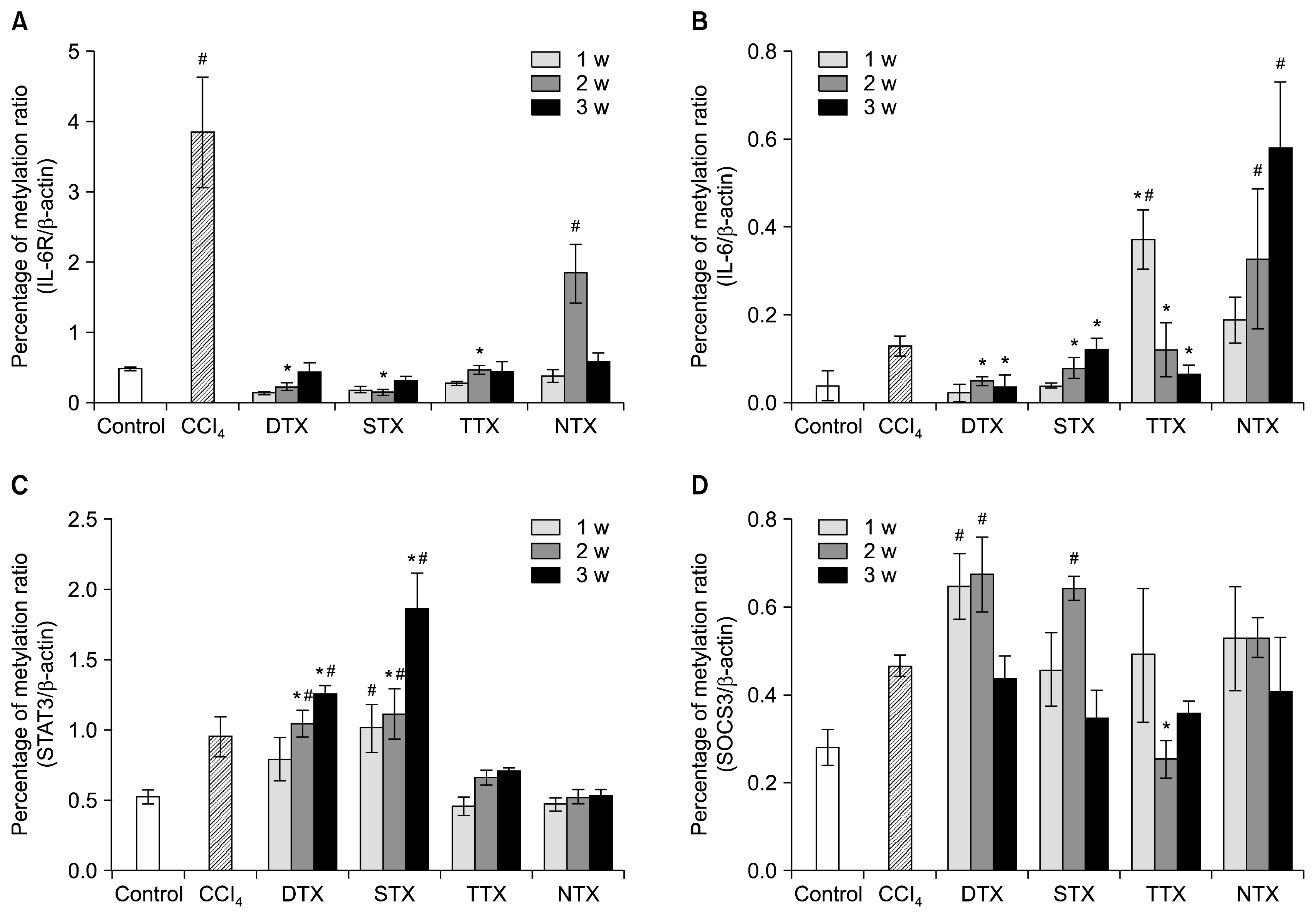2. Lee DS, Gil WH, Lee HH, Lee KW, Lee SK, Kim SJ, Choi SH, Heo JS, Hyon WS, Kim GS, Paik SW, Koh KC, Joh JW. Factors affecting graft survival after living donor liver transplantation. Transplant Proc. 2004; 36:2255–2256. DOI:
10.1016/j.transproceed.2004.08.073. PMID:
15561210.

4. Nussler A, Konig S, Ott M, Sokal E, Christ B, Thasler W, Brulport M, Gabelein G, Schormann W, Schulze M, Ellis E, Kraemer M, Nocken F, Fleig W, Manns M, Strom SC, Hengstler JG. Present status and perspectives of cell-based therapies for liver diseases. J Hepatol. 2006; 45:144–159. DOI:
10.1016/j.jhep.2006.04.002. PMID:
16730092.

5. Ren G, Chen X, Dong F, Li W, Ren X, Zhang Y, Shi Y. Concise review: mesenchymal stem cells and translational medicine: emerging issues. Stem Cells Transl Med. 2012; 1:51–58. DOI:
10.5966/sctm.2011-0019. PMID:
23197640. PMCID:
3727691.

6. Cai YF, Zhen ZJ, Min J, Fang TL, Chu ZH, Chen JS. Selection, proliferation and differentiation of bone marrow-derived liver stem cells with a culture system containing cholestatic serum in vitro. World J Gastroenterol. 2004; 10:3308–3312. PMID:
15484306.

7. Xu YQ, Liu ZC. Therapeutic potential of adult bone marrow stem cells in liver disease and delivery approaches. Stem Cell Rev. 2008; 4:101–112. DOI:
10.1007/s12015-008-9019-z. PMID:
18481229.

9. Chakraborty A, Lazova R, Davies S, Bäckvall H, Ponten F, Brash D, Pawelek J. Donor DNA in a renal cell carcinoma metastasis from a bone marrow transplant recipient. Bone Marrow Transplant. 2004; 34:183–186. DOI:
10.1038/sj.bmt.1704547. PMID:
15195072.

10. Yilmaz Y, Lazova R, Qumsiyeh M, Cooper D, Pawelek J. Donor Y chromosome in renal carcinoma cells of a female BMT recipient: visualization of putative BMT-tumor hybrids by FISH. Bone Marrow Transplant. 2005; 35:1021–1024. DOI:
10.1038/sj.bmt.1704939. PMID:
15778726.

11. Houlihan DD, Newsome PN. Critical review of clinical trials of bone marrow stem cells in liver disease. Gastroenterology. 2008; 135:438–450. DOI:
10.1053/j.gastro.2008.05.040. PMID:
18585384.

12. Barlow S, Brooke G, Chatterjee K, Price G, Pelekanos R, Rossetti T, Doody M, Venter D, Pain S, Gilshenan K, Atkinson K. Comparison of human placenta- and bone marrow-derived multipotent mesenchymal stem cells. Stem Cells Dev. 2008; 17:1095–1107. PMID:
19006451.

13. Parolini O, Alviano F, Bagnara GP, Bilic G, Bühring HJ, Evangelista M, Hennerbichler S, Liu B, Magatti M, Mao N, Miki T, Marongiu F, Nakajima H, Nikaido T, Portmann-Lanz CB, Sankar V, Soncini M, Stadler G, Surbek D, Takahashi TA, Redl H, Sakuragawa N, Wolbank S, Zeisberger S, Zisch A, Strom SC. Concise review: isolation and characterization of cells from human term placenta: outcome of the first international Workshop on Placenta Derived Stem Cells. Stem Cells. 2008; 26:300–311. DOI:
10.1634/stemcells.2007-0594.

14. Jones BJ, Brooke G, Atkinson K, McTaggart SJ. Immuno-suppression by placental indoleamine 2,3-dioxygenase: a role for mesenchymal stem cells. Placenta. 2007; 28:1174–1181. DOI:
10.1016/j.placenta.2007.07.001. PMID:
17714779.

15. Kim MJ, Shin KS, Jeon JH, Lee DR, Shim SH, Kim JK, Cha DH, Yoon TK, Kim GJ. Human chorionic- plate-derived mesenchymal stem cells and Wharton’s jelly-derived mesenchymal stem cells: a comparative analysis of their potential as placenta-derived stem cells. Cell Tissue Res. 2011; 346:53–64. PMID:
21987220.

16. Lee MJ, Jung J, Na KH, Moon JS, Lee HJ, Kim JH, Kim GI, Kwon SW, Hwang SG, Kim GJ. Anti-fibrotic effect of chorionic plate-derived mesenchymal stem cells isolated from human placenta in a rat model of CCl
4-injured liver: potential application to the treatment of hepatic diseases. J Cell Biochem. 2010; 111:1453–1463. PMID:
20830742.

17. Lee JM, Jung J, Lee HJ, Jeong SJ, Cho KJ, Hwang SG, Kim GJ. Comparison of immunomodulatory effects of placenta mesenchymal stem cells with bone marrow and adipose mesenchymal stem cells. Int Immunopharmacol. 2012; 13:219–224. PMID:
22487126.

18. Tsai PC, Fu TW, Chen YM, Ko TL, Chen TH, Shih YH, Hung SC, Fu YS. The therapeutic potential of human umbilical mesenchymal stem cells from Wharton’s jelly in the treatment of rat liver fibrosis. Liver Transpl. 2009; 15:484–495. PMID:
19399744.

19. Nakamura T, Torimura T, Sakamoto M, Hashimoto O, Taniguchi E, Inoue K, Sakata R, Kumashiro R, Murohara T, Ueno T, Sata M. Significance and therapeutic potential of endothelial progenitor cell transplantation in a cirrhotic liver rat model. Gastroenterology. 2007; 133:91–107. e101DOI:
10.1053/j.gastro.2007.03.110. PMID:
17631135.

21. Tiberio GA, Tiberio L, Benetti A, Cervi E, Montani N, Dreano M, Garotta G, Cerea K, Steimberg N, Pandolfo G, Ferrari-Bravo A, Mazzoleni G, Giulini SM, Schiaffonati L. IL-6 Promotes compensatory liver regeneration in cirrhotic rat after partial hepatectomy. Cytokine. 2008; 42:372–378. DOI:
10.1016/j.cyto.2008.03.012. PMID:
18455423.

22. Cressman DE, Greenbaum LE, DeAngelis RA, Ciliberto G, Furth EE, Poli V, Taub R. Liver failure and defective hepatocyte regeneration in interleukin-6-deficient mice. Science. 1996; 274:1379–1383. DOI:
10.1126/science.274.5291.1379. PMID:
8910279.

23. Taub R. Liver regeneration: from myth to mechanism. Nat Rev Mol Cell Biol. 2004; 5:836–847. DOI:
10.1038/nrm1489. PMID:
15459664.

24. Tron K, Samoylenko A, Musikowski G, Kobe F, Immenschuh S, Schaper F, Ramadori G, Kietzmann T. Regulation of rat heme oxygenase-1 expression by interleukin-6 via the Jak/STAT pathway in hepatocytes. J Hepatol. 2006; 45:72–80. DOI:
10.1016/j.jhep.2005.12.019. PMID:
16510205.

25. Song L, Webb NE, Song Y, Tuan RS. Identification and functional analysis of candidate genes regulating mesenchymal stem cell self-renewal and multipotency. Stem Cells. 2006; 24:1707–1718. DOI:
10.1634/stemcells.2005-0604. PMID:
16574750.

26. Menicanin D, Bartold PM, Zannettino AC, Gronthos S. Genomic profiling of mesenchymal stem cells. Stem Cell Rev. 2009; 5:36–50. DOI:
10.1007/s12015-009-9056-2. PMID:
19224407.

27. Reister S, Kordes C, Sawitza I, Häussinger D. The epigenetic regulation of stem cell factors in hepatic stellate cells. Stem Cells Dev. 2011; 20:1687–1699. DOI:
10.1089/scd.2010.0418. PMID:
21219128.

28. Robinson CM, Watson CJ, Baugh JA. Epigenetics within the matrix: a neo-regulator of fibrotic disease. Epigenetics. 2012; 7:987–993. DOI:
10.4161/epi.21567. PMID:
22894907. PMCID:
3515019.
29. Jung J, Choi JH, Lee Y, Park JW, Oh IH, Hwang SG, Kim KS, Kim GJ. Human placenta-derived mesenchymal stem cells promote hepatic regeneration in CCl
4-injured rat liver model via increased autophagic mechanism. Stem Cells. 2013; 31:1584–1596. DOI:
10.1002/stem.1396. PMID:
23592412.

30. Wuestefeld T, Klein C, Streetz KL, Betz U, Lauber J, Buer J, Manns MP, Müller W, Trautwein C. Interleukin-6/glyco-protein 130-dependent pathways are protective during liver regeneration. J Biol Chem. 2003; 278:11281–11288. DOI:
10.1074/jbc.M208470200. PMID:
12509437.

31. Sen GL, Reuter JA, Webster DE, Zhu L, Khavari PA. DNMT1 maintains progenitor function in self-renewing somatic tissue. Nature. 2010; 463:563–567. DOI:
10.1038/nature08683. PMID:
20081831. PMCID:
3050546.

32. Woo DH, Kim SK, Lim HJ, Heo J, Park HS, Kang GY, Kim SE, You HJ, Hoeppner DJ, Kim Y, Kwon H, Choi TH, Lee JH, Hong SH, Song KW, Ahn EK, Chenoweth JG, Tesar PJ, McKay RD, Kim JH. Direct and indirect contribution of human embryonic stem cell-derived hepatocyte-like cells to liver repair in mice. Gastroenterology. 2012; 142:602–611. DOI:
10.1053/j.gastro.2011.11.030.

34. Kuo TK, Hung SP, Chuang CH, Chen CT, Shih YR, Fang SC, Yang VW, Lee OK. Stem cell therapy for liver disease: parameters governing the success of using bone marrow mesenchymal stem cells. Gastroenterology. 2008; 134:2111– 2121. 2121 e2111–2113. DOI:
10.1053/j.gastro.2008.03.015. PMID:
18455168. PMCID:
3086672.

35. Lee Y, Jung J, Cho KJ, Lee SK, Park JW, Oh IH, Kim GJ. Increased SCF/c-kit by hypoxia promotes autophagy of human placental chorionic plate-derived mesenchymal stem cells via regulating the phosphorylation of mTOR. J Cell Biochem. 2013; 114:79–88. DOI:
10.1002/jcb.24303.

36. Jung J, Na KH, Lee MJ, Moon J, Kim GI, Jang JJ, Hwang SG, Kim GJ. Efficacy of chorionic plate-derived mesenchymal stem cells isolated from placenta in CCl
4-injured rat model depends on transplantation routes. Tissue Engineering and Regenerative Medicine. 2013; 10:10–17. DOI:
10.1007/s13770-013-0364-x.

37. Tilg H, Wilmer A, Vogel W, Herold M, Nölchen B, Judmaier G, Huber C. Serum levels of cytokines in chronic liver diseases. Gastroenterology. 1992; 103:264–274. PMID:
1612333.

38. Streetz KL, Tacke F, Leifeld L, Wüstefeld T, Graw A, Klein C, Kamino K, Spengler U, Kreipe H, Kubicka S, Müller W, Manns MP, Trautwein C. Interleukin 6/gp130-dependent pathways are protective during chronic liver diseases. Hepatology. 2003; 38:218–229. DOI:
10.1053/jhep.2003.50268. PMID:
12830005.

39. Ren X, Hu B, Colletti L. Stem cell factor and its receptor, c-kit, are important for hepatocyte proliferation in wild-type and tumor necrosis factor receptor-1 knockout mice after 70% hepatectomy. Surgery. 2008; 143:790–802. DOI:
10.1016/j.surg.2008.03.021. PMID:
18549896. PMCID:
2495772.

40. D’Anello L, Sansone P, Storci G, Mitrugno V, D’Uva G, Chieco P, Bonafé M. Epigenetic control of the basal-like gene expression profile via Interleukin-6 in breast cancer cells. Mol Cancer. 2010; 9:300. DOI:
10.1186/1476-4598-9-300. PMCID:
3002335.









 PDF
PDF Citation
Citation Print
Print


 XML Download
XML Download